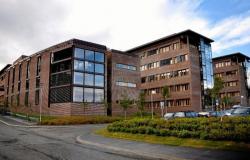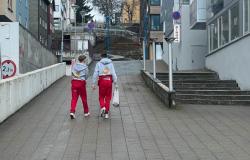– Here I see the result of intensive timber transport. In practice, this road is not suitable for this type of transport.
Section leader John Martin Jacobsen in Vestland county municipality sits on his knees with a measuring stick on the county road Skauvegen near Myking in the forestry municipality of Alver.
Wheel tracks in the cracked asphalt are nine centimeters deep.
– This is dangerous for traffic, he states.
For comparison, national roads must have a maximum of 2.5 cm deep wheel tracks.
A new survey shows that around 20 per cent of the county roads in Vestland are in critical need of strengthening measures.
– This corresponds to the Bergen – Oslo round trip. Equipping this will cost over NOK 4 billion, says Jacobsen.
Logging for Børslid Skog AS has been put on hold, because the weak county road out of the area is now closed to logging trucks.
Photo: Børslid Skog AS
– Far from enough in NTP
Vestland is far from alone in having bad county roads.
In its proposal for the National Transport Plan (NTP) for the next twelve years, the government has promised NOK 16 billion for the operation and maintenance of county roads.
The county, the Norwegian Road Administration and the car organization NAF say the need is actually up to NOK 100 billion.
The Storting will adopt the NTP on 12 June.
– The money in the NTP proposal is a good start, but far from enough. When the most urgent road reinforcement in Vestland county alone costs NOK 4 billion, it says something about the need, says county mayor Jon Askeland (Sp).
The county roads in his county have their own a maintenance backlog of around NOK 20 billion.
– These are important everyday roads. They are important as school and commuter roads and for all business transport, not just for the timber industry, he says.
Norway’s largest logging
Skauvegen in Alver runs through an area with extensive forestry. In November, Børslid Skog AS started harvesting the so-called Munck forests, which were planted in the 1950s and 60s.
In total, up to 60,000 cubic meters of spruce will be felled.
– This is the largest single felling in Western Norway ever, and it is extremely large in a national context, says Helge Kårstad, project manager in Coastal forestry.
Nortømmer AS, which carries out the felling for Børslid, has never had a major stand-alone timber felling in the company’s 25-year history. Daily manager Per Kveseth confirms this.
Nor do the co-operative Norwegian Forest Owners’ Association know whether any forest owners elsewhere in the country have had a large individual felling.
At the end of a narrow and winding county road lies the timber quay at Eidsnes in Alver, where the logs are shipped further to sea.
Photo: Leif Rune Løland / NRK
In order to contribute to efficient timber transport, Vestland county council last year increased the limit for how large vehicles could drive on Skauvegen.
The timber trucks refuse to drive
But this spring, severe damage was discovered in the road foundation.
Now, Vestland county council therefore forbids the logging trucks to drive here, so the logging has been stopped about halfway.
– We are concerned about whether the county roads tolerate this transport. Measures must be taken before transport can resumesays Jacobsen.
The logging in Smørdalen near Myking is the country’s largest single logging: around 60,000 cubic meters of timber from 1.3 square kilometers of the Munck forests. But damage to county roads (below right) has now stopped logging. The picture was taken last week.
Photo: Børslid Skog AS
Necessary improvement of Skauvegen and Mykingvegen will cost over NOK 10 million.
– These are funds that I do not have in the budget for this year.
He believes the contrast between private forest vehicle roads and public county roads is paradoxical.
– Not the timber trucks’ fault
But Kårstad disagrees that the timber trucks are the main cause of damaged county roads.
– These are old roads that were built in another time. The bedrock masses are weak. This winter, frost has given a lot telehive and bumps everywhere. It is not the activity of forestry that has led to that, he says.
Kårstad nevertheless admits that heavy timber transport on roads with telehives may have worsened the road condition.
– Then there will be major, permanent damage to the road. And it only increases gradually as the water penetrates more and more. But if the problem of crack formation is to be solved, something must be done about the subsoil in the road.
Inspection of the damaged Skauvegen in Alver. From left: Control engineer Johannes Dale, section leader John Martin Jacobsen and county mayor Jon Askeland in Vestland county municipality, and Helge Kårstad in Coastal Forestry.
Photo: Leif Rune Løland / NRK
Increasing timber transport on bad roads
The timber from, among other things, the Munck forests is driven down to Eidsnes timber wharf. From there it is transported by sea.
The many huge piles of fir logs on the quay show that the international demand is strong. And timber production is expected to increase for at least another 20 years.
According to the plan, timber production in Vestland is to be doubled to 1 million cubic metres. This corresponds to 10 percent of the total Norwegian logging today.
– There is more and more forest that is ready for felling and must be transported out onto the public road network. The county roads are not suitable for this, says Jacobsen.
On the county road down to Eidsnes timber quay, there is a lot of wear on the asphalt. Control engineer Johannes Dale measures a hole more than 50 cm deep, together with section leader John Martin Jacobsen.
Photo: Leif Rune Løland / NRK
Afraid of logging stop
Kårstad fears that the consequence will be that valuable timber cannot be felled.
– The alternative is that the cars have to put the trailer down and drive back and forth 8-9 times to fill one load. But then the load on vegans will be even greater, because the axle pressure at the front of the cars is great, he says.
– One is forced to do something. Therefore, it is almost like a dream that the county council will set aside funds to improve the worst points on the county’s roads, says Kårstad.
Here you can see NRK’s stories about it
National Transport Plan.







